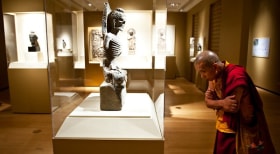
“The Buddhist Heritage of Pakistan: Art of Gandhara”
August 8th through October 30th.
Asia Society, 725 Park Avenue, at 70th Street
(212) 288-6400
asiasociety.org.
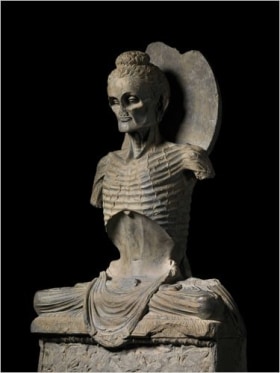
The Bumper Emaciated Buddha at Nancy Wiener Gallery is featured in The New York Times
Holland Cotter writes:
"An exhibition of Gandharan sculpture that was to open at Asia Society this month was postponed because of political turmoil in Pakistan, the source of most of the loans. But one of the show’s most spectacular pieces, the sculpture “Emaciated Siddhartha,” from the Bumper Collection in Canada, is installed at Nancy Wiener (in the Trezza Gallery, 39 East 78th Street, through Thursday).
In his quest for enlightenment, Siddhartha stripped off his princely finery, and submitted himself to years of grueling deprivations. The sculpture shows him at the end of that, skin and bones, barely human. Very soon he will discover the wisdom of the middle, moderate way to salvation. He’ll have a bite, gain a little weight, make the world a happier place. The sculpture makes art lovers happy right now."
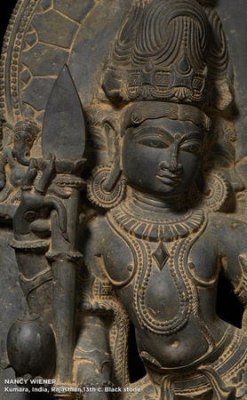
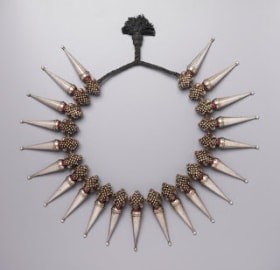
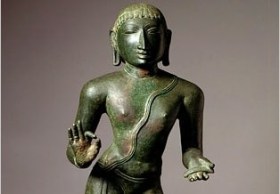
Holland Cotter writes:
"Ms. Wiener has consistently rustled up outstanding Southeast Asian work for Asia Week. This year is no exception on the evidence of her 11th-century Khmer carving of the Buddha sitting on the coiled body of the serpent king Muchalinda, who protected him at Bodh Gaya. The Buddha’s form is all but abstract, but the snake’s is straight from nature: you can see the curving spine under the skin, and every inch of skin is incised with fine, scalelike patterning."

" 'The market is pretty healthy,' said Nancy Weiner, a 25-year veteran who sells classical Indian and Southeast Asian sculpture, silver and gold jewelry from her handsome gallery in the Ansonia, 2109 Broadway. 'There is a larger collecting community today than ever.' "
A Khmer Krishna Kaliya from Nancy Wiener Gallery is reproduced in this article.

Holland Cotter writes: "To its credit, the Asian fair struggles impressively. Its signature suaveness is intact, and it still has some memorable art moments. A small, fabulous Khmer bronze of the god Krishna doing a Martha Graham kick is among them. It’s at Nancy Wiener’s booth, along with an early Indian Buddhist sandstone frieze that distills an entire history of muted devotional joy. It is to weep for."
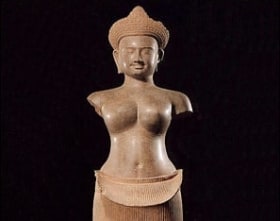
Roberta Smith writes:
"This said, some of the fair's stalwarts have put up wonderful work this year, including Nancy Wiener (daughter of Doris Wiener), whose display of Southeast Asian sculptures is overseen by a serene 10th-century Khmer sandstone statue of the Hindu goddess Lakshmi."
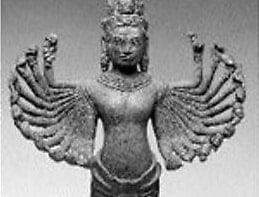
Jyotirmoy Datta writes:
"At Nancy Weiner Gallery’s stand at the 7th Armory, there was a goddess to beat all other goddesses, even the 10-armed Durga — a 22-armed, 11-headed Khmer Prajnaparamita."

Holland Cotter writes:
"Mr. Eskenazi's booth is itself an art fair classic: you drop by every year wondering if it'll blow you away again, and it does. The same goes for Doris and Nancy Wiener's display. It's particularly rich in Khmer sculptures this time, among them a small bronze statue of the goddess Prajnaparamita, the symbolic mother of us all, whose dozens of raised protective arms look like unfolding wings."

Holland Cotter writes:
"Not that art doesn't present political problems of its own. At Nancy Wiener, photographs of the Indian Buddhist site Amaravati by the British Army captain Linnaeus Tripe (1822-1902) filter ancient art through modern technology to riveting effect. But they also say complicated things about photography's unbenign role as a proprietary instrument of the colonial enterprise."

Holland Cotter writes:
"What pushes the Asian Fair into the must-see category, though, is its wealth of South Asian art. On the whole, New York gets a healthy diet of Chinese and Japanese work these days. But even a subsistence helping of Indian art is rare, and this is what the fair provides.
Just go to the booth shared by Doris and Nancy Wiener, where you will see a heart-stopping 10th-century sculpture of a divine maiden carved from West Indian marble and a small, shapely figure of the goddess of music, Sarasvati, her finger poised on the string of her vina. Their voluptuousness is tempered by the figure of a seated nude Jain deity as light and cool as a rain cloud."